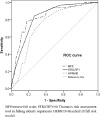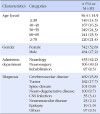Abstract
Purpose
The aim of the study was to identify the most appropriate fall-risk assessment tool for neurological patients in an acute care setting.
Methods
This descriptive study compared the reliability and validity of three fall-risk assessment tools (Morse Fall Scale, MFS; St Thomas's Risk Assessment Tool in Falling Elderly Inpatients, STRATIFY; Hendrich II Fall Risk Model, HFRM II). We assessed patients who were admitted to the Department of Neurology, Neurosurgery, and Rehabilitation at Asan Medical Center between July 1 and October 31, 2011, using a constructive questionnaire including general and clinical characteristics, and each item from the three tools. We analyzed inter-rater reliability with the kappa value, and the sensitivity, specificity, predictive value, and the area under the curve (AUC) of the three tools.
Results
The analysis included 1,026 patients, and 32 falls occurred during this study. Inter-rater reliability was above 80% in all three tools. and the sensitivity was 50.0% (MFS), 84.4%(STRATIFY), and 59.4%(HFRM II). The AUC of the STRATIFY was 82.8. However, when the cutoff point was regulated as not 50 but 40 points, the AUC of the MFS was higher at 83.7.
Figures and Tables
References
1. Advanced Analytics. Inter-rater reliability discussion corner by Kilem L. Gwet-sample size determination. 2010. Retrieved May 1, 2011. Web site: http://agreestat.com/blog_irr/sample_size_determination.html.
2. Australian Council for Safety and Quality in Health Care. Preventing falls and harm from falls in older people: Best practice guidelines for Australian hospitals and residential aged care facilities. Safety and Quality Council, Canberra, Australia: Author;2005.
3. Barker A, Kamar J, Graco M, Lawlor V, Hill K. Adding value to the STRATIFY falls risk assessment in acute hospitals. Journal of Advanced Nursing. 2011; 67:450–457. DOI: 10.1111/j.1365-2648.2010.05503.x.

4. Chapman J, Bachand D, Hyrkas T. Testing of the sensitivity, specificity and feasibility of four falls risk assessment tools in a clinical setting. Journal of Nursing Management. 2011; 19:133–142. DOI: 10.1111/j.1365-2834.2010.01218.x.
5. Eagle DJ, Salama S, Whitman D, Evans LA, Ho E, Olde J. Comparison of three instruments in predicting accidental falls in selected inpatients in a general teaching hospital. Journal of Gerontological Nursing. 1999; 25(7):40–45. PMID:10476130.

6. Evans D, Hodgkinson B, Lambert L, Wood J, Kowanko I. Falls in acute hospitals: A systematic review. The Joanna Briggs Institute for evidence based nursing and midwifery;1998. in conjunction with the royal adelaide hospital, adelaide, South Australia. National Library of Australia Cataloguing-in-publication data ISBN Number: 0-9586131-2-5.
7. Friedman SM, Munoz B, West SK, Rubin GS, Fried LP. Falls and fear of falling: Which comes first? A longitudinal prediction model suggests strategies for primary and secondary prevention. Journal of American Geriatric Society. 2002; 50:1329–1335. DOI: 10.1046/j.1532-5415.2002.50352.x.

8. Gu MO, Jeon MY, Eun Y. The development and effect of an tailored falls prevention exercise for older adults. Journal of Korean Academy of Nursing. 2006; 36:341–352.

9. Harlein J, Halfens RJ, Dassen T, Lahmann NA. Falls in older hospital inpatients and the effect of cognitive impairment: A secondary analysis of prevalence studies. Journal of Clinical Nursing. 2011; 20:175–183. DOI: 10.1111/j.1365-2702.2010.03460.x.
10. Heinze C, Halfens RJ, Roll S, Dassen T. Psychometric evaluation of the Hendrich Fall Risk Model. Journal of Advanced Nursing. 2006; 53:327–332. DOI: 10.1111/j.1365-2648.2006.03728.x.

11. Hendrich AL, Bender PS, Nyhuis A. Validation of the Hendrich II Fall Risk Model: A large concurrent case/control study of hospitalized patients. Applied Nursing Research. 2003; 16:9–21. DOI: 10.1053/apnr.2003.YAPNR2.

12. Hur JY, Kim HJ. Relationship of risk factors, knowledge and attitude to falls in elderly in patients. Journal of Korean Gerontological Nursing. 2009; 11:38–50.
13. Jang IS, Kim DJ. Home safety assessment for fall prevention in elderly people in a rural community. Journal of Korean Gerontological Nursing. 2002; 4:176–186.
14. Kim EA, Mordiffi SZ, Bee WH, Devi K, Evans D. Evaluation of three fall-risk assessment tools in an acute care setting. Journal of Advanced Nursing. 2007; 60:427–435. DOI: 10.1111/j.1365-2648.2007.04419.x.

15. Lovallo C, Rolandi S, Rossetti AM, Lusignani M. Accidental falls in hospital inpatients: Evaluation of sensitivity and specificity of two risk assessment tools. Journal of Advanced Nursing. 2010; 66:690–696. DOI: 10.1111/j.1365-2648.2009.05231.x.

16. Milisen K, Staelens N, Schwendimann R, Paepe LD, Verhaeghe J, Braes T, et al. Fall prediction in inpatients by bedside nurses using the St. Thomas's Risk Assessment Tool in Falling Elderly Inpatients (STRATIFY) instrument: A multicenter study. Journal of the American Geriatrics Society. 2007; 55:725–733. DOI: 10.1111/j.1532-5415.2007.01151.x.

17. Morse JM, Morse RM, Tylko SJ. Development of a scale to identify the fall-prone patient. Canadian Journal on Aging. 1989; 8:366–371. DOI: 10.1017/S0714980800008576.

18. Myers H. Hospital fall risk assessment tools: A critique of the literature. International Journal of Nursing Practice. 2003; 9:223–235. DOI: 10.1046/j.1440-172X.2003.00430.x.

19. Myers H, Nikoletti S. Fall risk assessment: A prospective investigation of nurses' clinical judgement and risk assessment tools in predicting patient falls. International Journal of Nursing Practice. 2003; 9:158–165. DOI: 10.1046/j.1440-172X.2003.00409.x.

20. O'Connell B, Myers H. The sensitivity and specificity of the Morse Fall Scale in an acute care setting. Journal of Clinical Nursing. 2002; 11:134–136. DOI: 10.1046/j.1365-2702.2002.00578.x.
21. Oliver D, Britton M, Seed P, Martin FC, Hopper AH. Development and evaluation of evidence based risk assessment tool (STRATIFY) to predict which elderly inpatients will fall: Case-control and cohort studies. British Medical Journal. 1997; 315:1049–1053. DOI: 10.1136/bmj.315.7115.1049.

22. Oliver D, Papaioannou A, Giangregorio L, Thabane L, Reizgys K, Foster G. A systematic review and meta-analysis of studies using the STRATIFY tool for prediction of falls in hospital patients: How well does it work? Age and Ageing. 2008; 37:621–627. DOI: 10.1093/ageing/afn203.

23. Papaioannou A, Parkinson W, Cook R, Ferko N, Coker E, Adachi JD. Prediction of falls using a risk assessment tool in the acute care setting. BMC Medicine. 2004; 2:1. DOI: 10.1186/1741-7015-2-1.

24. Perell KL, Nelson A, Goldman RL, Luther SL, Prieto-Lewis N, Rubenstein LZ. Fall risk assessment measures: An analytic review. Journal of Gerontology Series A: Biological Sciences and Medical Scienc. s. 2001; 56:M761–M766. PMID: 11723150.
25. Petitpierre NJ, Trombetti A, Carroll I, Michel JP, Herrmann FR. The FIM instrument to identify patients at risk of falling in geriatric wards: A 10-year retrospective study. Age and Ageing. 2010; 39:326–331. DOI: 10.1093/ageing/afq010.
26. Ryu YM, Roche JP, Brunton M. Patient and family education for fall prevention involving patients and families in a fall prevention program on a neuroscience unit. Journal of Nursing Care Quality. 2009; 24:243–249. DOI: 10.1097/NCQ.0b013e318194fd7c.




 PDF
PDF ePub
ePub Citation
Citation Print
Print







 XML Download
XML Download